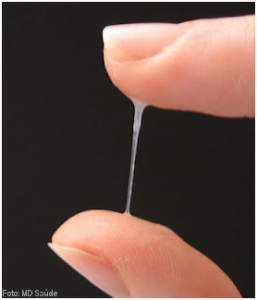A method I find very interesting, but that only a few doctors recommend is the Billings Method1. This method is simple but very interesting and is very helpful for those who want to get pregnant. In addition to getting to know your body, women can detect the phases that their cervical mucus goes through during the menstrual cycle and distinguish between dry, moist, and also fertile or not.
The Billings Method involves detecting ovulation by means of vaginal moisture and the menstrual period through cervical mucus. Let’s understand it this way: for example, we count 28 days from the first day of the menstrual cycle, the day when you see fresh red blood. Let’s say my bleeding lasts for 7 days, so we count from the 8th day to the 19th day as the fertile window. During this period, you can notice ovulation by the moisture in the vagina and the Billings Method.
See below for a sequence of the likely mucus types during the cycle
Characteristics of the Mucus After Menstruation
Right after menstruation, most women present with progesterone mucus which may be opaque and milky and the vagina may feel somewhat dryer. This mucus can also look like a cream or moisturizer.
The change in mucus is due to the rise in progesterone2. As ovulation approaches, the mucus becomes viscous, firmer, and once again opaque, but now more abundant. Even closer to ovulation, the mucus becomes elastic (like uncooked egg white) and the vagina becomes moister.
What Is the Most Fertile Mucus?
The mucus starts to transform into a stringy consistency that stretches if pulled between the fingers, very similar to a clear jelly or often yellowish. When ovulation finally arrives, the mucus is fully elastic or has a soapy appearance, making it easier for sperm to reach the egg.
After this period, the mucus once again becomes milky or thicker with little white lumps and can also look like a cream due to progesterone, which is different from white discharge. If done correctly, the Billings Method can be a very effective ally, which is why it’s so important to learn to know your body3 as soon as possible.
When Does Menstruation Occur?
Menstruation is expected to occur between the 26th and 28th day of a cycle, but there are cases like mine where the cycle lasts 30 or 33 days, sometimes even longer! So, the best thing to do is to calculate according to your own menstrual cycle, whether regular or not. Some women, even during their fertile window, cannot notice these changes in their bodies and that’s where another equally interesting method comes in, which is basal temperature.













